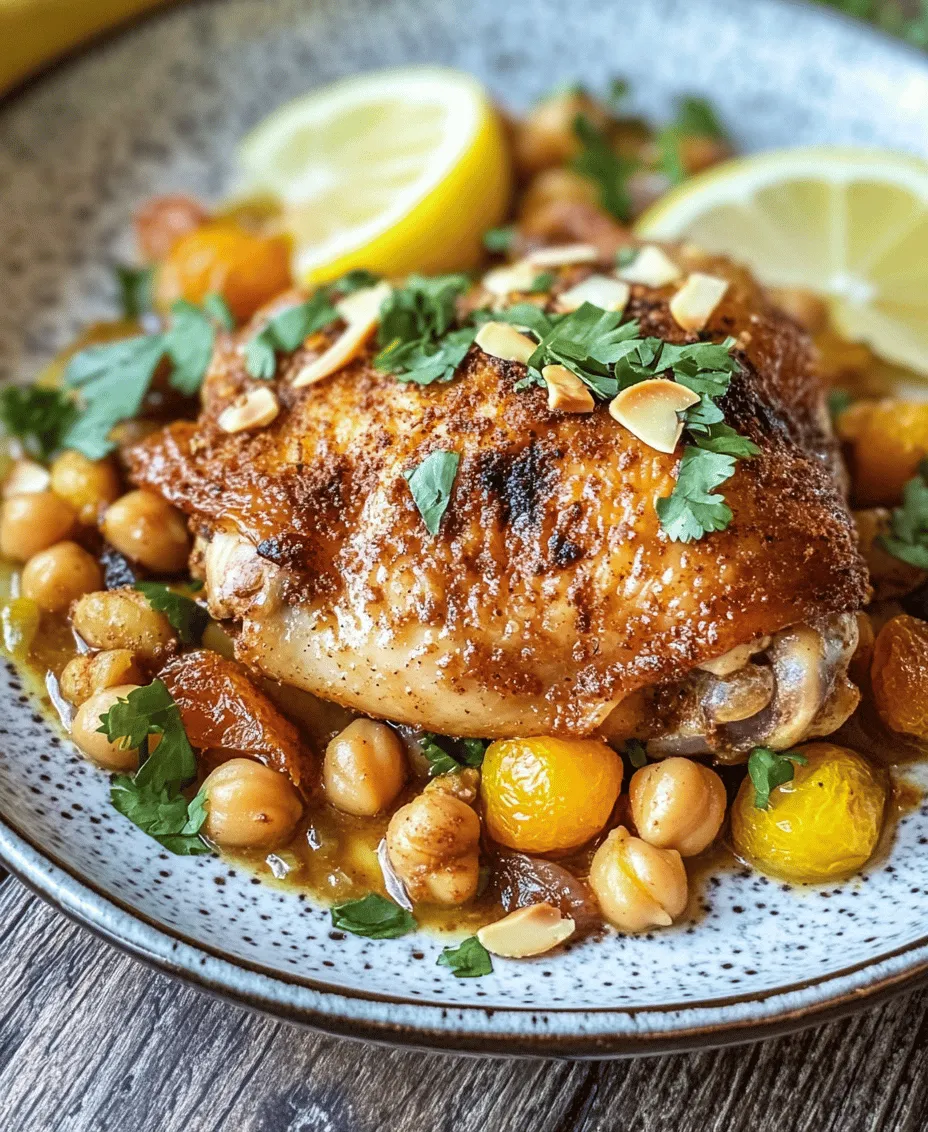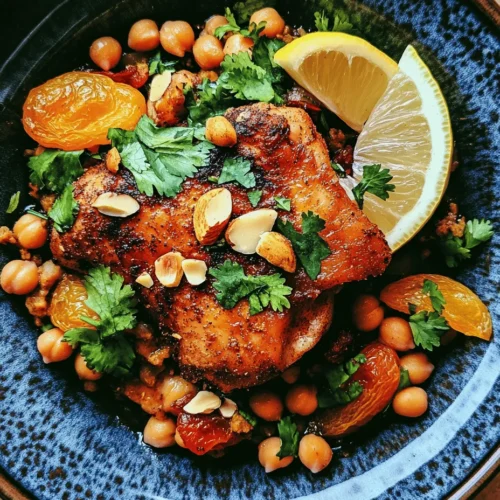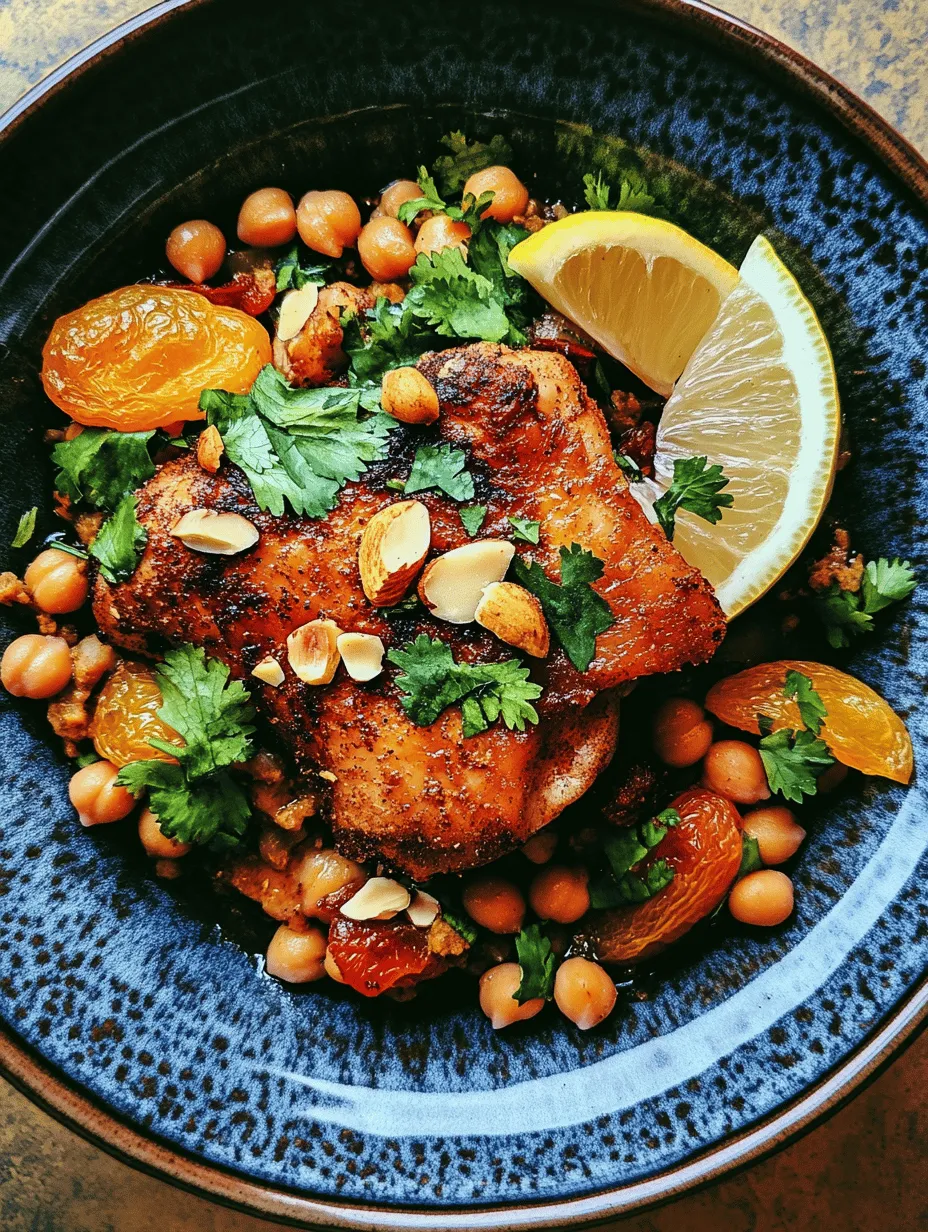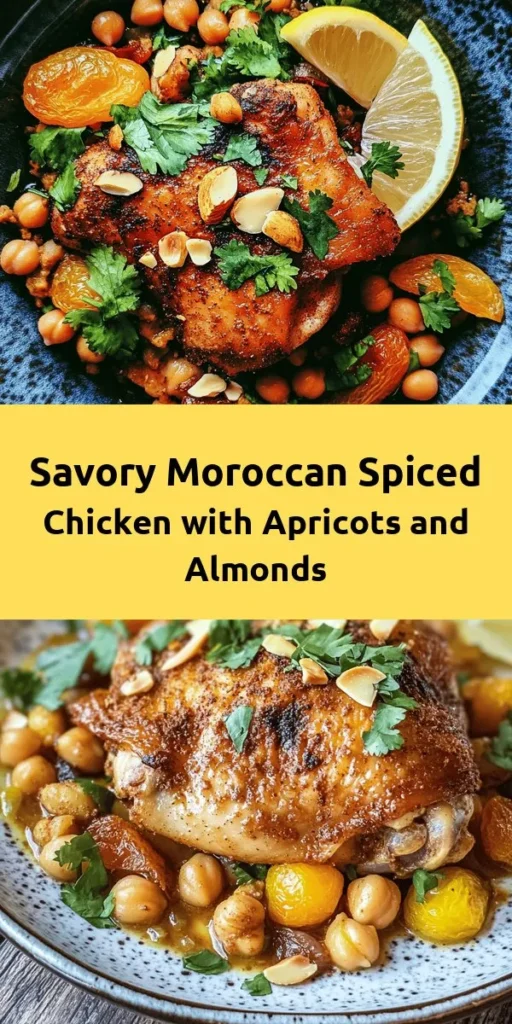Introduction
Moroccan cuisine is a culinary treasure trove, celebrated for its rich tapestry of flavors, colors, and aromas. Drawing on a variety of cultural influences, Moroccan dishes often showcase the unique interplay between spices, herbs, and fresh ingredients. One standout among these delightful offerings is Moroccan Spiced Chicken, a dish that embodies the heart of Moroccan cooking.
This dish is not just a meal; it’s an experience that transports you to the vibrant souks of Marrakech or the serene landscapes of the Atlas Mountains. The combination of spices and ingredients not only brings out the natural flavors of the chicken but also adds depth and warmth to every bite. Moroccan Spiced Chicken is beloved for its balance of savory and sweet notes, making it a perfect dish for any occasion—be it a weeknight dinner or a festive gathering.
At the core of this recipe is the mastery of spices, which play a crucial role in enhancing the flavor profile of the chicken. The unique blend of spices used in Moroccan cooking not only adds complexity but also contributes to the dish’s aromatic allure. With the right approach to preparation, you can elevate simple chicken into a spectacular centerpiece that your family and friends will rave about.
Understanding the Ingredients
To create an authentic Moroccan Spiced Chicken, it’s essential to understand the key ingredients that contribute to its distinctive flavor and texture. Each component is thoughtfully selected to ensure a harmonious balance that defines Moroccan cuisine.
Chicken Thighs: Why Bone-In and Skin-On is Preferred
When it comes to choosing the right cut of chicken for this recipe, bone-in, skin-on chicken thighs are the ideal option. Unlike chicken breasts, which can dry out during cooking, thighs retain moisture thanks to their higher fat content. The bone also adds flavor and richness to the dish as it simmers. The skin, when browned, provides a delightful crispiness that contrasts beautifully with the tender meat underneath. This choice not only enhances the savory profile of the dish but also ensures that each piece of chicken is bursting with flavor.
Olive Oil: Health Benefits and Flavor Enhancement
Olive oil is a staple in Moroccan cuisine and plays a pivotal role in this recipe. Known for its heart-healthy monounsaturated fats, olive oil is a nutritious choice that also enhances flavor. When used in marinating the chicken, it helps to keep the meat moist and tender while imparting its rich, fruity notes. Additionally, olive oil serves as a base for sautéing the onions and garlic, allowing their flavors to meld beautifully with the spices.
Spices: The Role of Cumin, Coriander, Paprika, Cinnamon, and Cayenne
The magic of Moroccan Spiced Chicken lies in its spices. A carefully curated blend of cumin, coriander, paprika, cinnamon, and cayenne creates a complex flavor profile that is both warming and invigorating.
– Cumin lends a nutty, earthy flavor that is quintessential in Moroccan dishes.
– Coriander adds a hint of citrus and sweetness, balancing the depth of the other spices.
– Paprika contributes vibrant color and a mild sweetness, while also providing a gentle smokiness.
– Cinnamon brings warmth and a touch of sweetness, making it a unique addition that enhances the overall flavor.
– Cayenne offers a subtle heat, allowing you to adjust the spice level to your preference.
This aromatic combination transforms the chicken into a dish that is both comforting and exotic.
Chickpeas: Nutritional Benefits and Texture
In addition to the chicken, chickpeas are a key ingredient that adds nutritional value and texture to the dish. Packed with protein, fiber, and essential vitamins, chickpeas are a fantastic addition for those looking to create a more balanced meal. Their creamy texture complements the tender chicken, and they absorb the spices beautifully, making every bite satisfying.
Dried Apricots: Sweetness and Moisture Contribution
Dried apricots introduce a delightful sweetness that contrasts the savory spices. As they cook, they soften and release their natural sugars, which adds depth to the sauce. This balance of sweet and savory is a hallmark of Moroccan cuisine, making dried apricots an essential ingredient in this recipe.
Almonds: Crunch and Nutty Flavor Profile
To finish off the dish, sliced or chopped almonds provide an appealing crunch and a nutty flavor that enhances the overall experience. Their toasted aroma adds a layer of complexity, while also offering a satisfying texture contrast to the tender chicken and creamy chickpeas.
Fresh Herbs and Garnishes: Enhancing the Dish
Finally, fresh herbs such as cilantro or parsley are essential for garnishing Moroccan Spiced Chicken. Not only do they add a pop of color, but they also bring brightness and freshness to the dish. The vibrant herbs balance the richness of the chicken and the spices, making each bite refreshing and delightful.
Preparing Moroccan Spiced Chicken: A Step-by-Step Guide
The preparation of Moroccan Spiced Chicken involves a few key steps that ensure the flavors meld together beautifully and that the chicken is cooked to perfection. Here’s a detailed guide to get you started.
Marination: Importance of Marinating Chicken for Flavor Infusion
Marinating the chicken is a crucial step in the preparation process. A well-crafted marinade infuses the meat with flavor and ensures it remains succulent during cooking. For this recipe, combine olive oil, minced garlic, and the selected spices in a bowl. The acidity from the marinade helps to tenderize the chicken while allowing the spices to penetrate deeply.
Creating the Marinade
To create the marinade, follow these simple steps:
1. In a mixing bowl, combine 1/4 cup of olive oil, 4 cloves of minced garlic, 1 teaspoon of cumin, 1 teaspoon of coriander, 1 teaspoon of paprika, 1/2 teaspoon of ground cinnamon, and a pinch of cayenne pepper (adjust to taste).
2. Add salt and black pepper to taste, ensuring the mixture is well-seasoned.
3. Whisk the ingredients together until fully combined, creating a fragrant paste.
Marinating Time and Methods
Once the marinade is ready, add the chicken thighs to the bowl, ensuring they are thoroughly coated. For optimal flavor infusion, cover the bowl with plastic wrap and refrigerate for at least 1 hour. If time allows, marinating the chicken overnight will yield even better results, allowing the spices to permeate deeply into the meat.
Sautéing the Onions and Garlic: Techniques for Achieving the Right Texture and Flavor
While the chicken marinates, begin preparing the base for your dish. Heat a tablespoon of olive oil in a large skillet or Dutch oven over medium heat. Once the oil is hot, add finely chopped onions and sauté until they become translucent and fragrant, about 5 minutes. This process releases the natural sweetness of the onions, creating a flavorful foundation for your chicken.
Next, add a few cloves of minced garlic to the pan and sauté for an additional minute, being careful not to let the garlic burn. The combination of sautéed onions and garlic will create a robust aroma that sets the stage for the spices to shine.
Browning the Chicken: Insights on Searing for Optimal Results
Once the onions and garlic are perfectly sautéed, it’s time to add the marinated chicken to the skillet. Carefully place each thigh skin-side down in the hot pan, allowing them to sear for about 5-7 minutes until the skin is golden brown and crispy. This step is important as it develops a rich flavor and creates a beautiful texture that enhances the dish.
After browning the chicken on one side, flip the thighs and cook for an additional 5 minutes. At this point, the chicken may not be fully cooked through, but it will have developed a delicious crust that will retain moisture during the next stages of cooking.
With the chicken seared and the base of onions and garlic prepared, you are now ready to move forward with the next steps in creating the Moroccan Spiced Chicken. The layering of flavors and careful preparation will ensure that this dish becomes a favorite in your culinary repertoire. Stay tuned for further instructions on how to bring this vibrant dish to life.

Maillard Reaction and Its Impact on Flavor
When it comes to cooking, understanding the science behind flavor development can elevate your culinary skills. One key process that significantly enhances flavor is the Maillard reaction. This complex chemical reaction occurs when proteins and sugars in food undergo a transformation due to heat, resulting in the browning and development of complex flavors. In the case of our Moroccan Spiced Chicken, achieving a golden-brown sear on the chicken pieces is essential. Not only does this enhance the dish’s aesthetic appeal, but it also creates a depth of flavor that makes each bite truly unforgettable.
To achieve this, ensure your pan is adequately preheated before adding the chicken. The high heat will promote the Maillard reaction, allowing for that delightful crust to form. As you cook, listen for the satisfying sizzle; this sound indicates that the process is underway. Remember, patience is key. Resist the urge to move the chicken around too much; instead, allow it to sear undisturbed to develop that rich, savory flavor.
Simmering the Dish: Importance of Slow Cooking for Tenderness
After achieving that perfect sear, the next step is to simmer the chicken. Slow cooking is crucial for developing tenderness, allowing the flavors to meld beautifully while ensuring the chicken becomes moist and succulent. Simmering allows the collagen in the chicken to break down, contributing to a tender texture that practically melts in your mouth.
To achieve the perfect simmer, you will want to bring your chicken broth to a gentle boil before reducing the heat. This ensures that the dish cooks evenly without boiling too aggressively, which can lead to tough, dry chicken. The gentle bubbling contributes to an infusion of flavors, as the spices permeate the chicken and broth, creating a rich and aromatic sauce.
Finishing Touches with Almonds: Why Adding Them at the End Enhances the Dish
As the chicken nears completion, it’s time to add the finishing touch: toasted almonds. Adding almonds towards the end of the cooking process serves multiple purposes. First, it provides a delightful crunch that contrasts beautifully with the tender chicken. Secondly, the toasting process enhances the nutty flavor of the almonds, enriching the overall dish.
To toast the almonds, simply place them in a dry skillet over medium heat for a few minutes, stirring frequently until they turn golden brown. This step only takes a moment, but it makes a significant difference in flavor. Once toasted, sprinkle the almonds over the Moroccan Spiced Chicken just before serving for that perfect finishing touch.
Serving Suggestions and Pairings
Ideal Serving Temperature and Presentation Tips
For the best experience, serve your Moroccan Spiced Chicken hot, straight from the pot. The vibrant colors of the dish—golden chicken, vibrant spices, and the sprinkle of toasted almonds—make for an enticing presentation. Consider using a large, shallow serving dish, allowing the sauce to pool at the bottom while showcasing the chicken and almonds on top. Garnish with fresh cilantro or parsley for an added pop of color and freshness.
Recommended Sides: Couscous, Crusty Bread, or Rice
Moroccan cuisine is well-known for its complementary side dishes, and Moroccan Spiced Chicken is no exception. To enhance your meal, serve it alongside light, fluffy couscous. The grains will soak up the flavorful sauce, providing a perfect balance to the spiced chicken. Alternatively, serve with crusty bread to mop up the delicious sauce, or pair it with fragrant rice, which also complements the dish beautifully.
Beverage Pairings that Complement the Flavors of Moroccan Spiced Chicken
When it comes to beverages, consider a light red wine, such as a Pinot Noir or Grenache, which can enhance the dish’s flavors without overpowering them. If you prefer non-alcoholic options, a refreshing mint tea or a fruity pomegranate juice can also pair excellently with the spices, providing a palate-cleansing contrast to the richness of the chicken.
Cultural Significance of Moroccan Spices
Overview of How Spices Play a Role in Moroccan Culture and Cuisine
In Moroccan culture, spices are not just ingredients; they are a way of life. The rich tapestry of Moroccan cuisine is woven with an array of spices, each with its own unique story and significance. Spices like cumin, coriander, cinnamon, and saffron are integral to not only flavoring dishes but also reflecting Morocco’s diverse history and cultural influences.
Historical Context of the Spices Used in the Recipe
The spices used in Moroccan Spiced Chicken have historical roots that trace back centuries. Many spices were introduced during the spice trade, making their way to Morocco from distant lands. For instance, cinnamon was once a luxury item, valued for both its flavor and medicinal properties. Today, these spices are accessible and celebrated, forming the backbone of Moroccan cooking and offering a glimpse into the country’s vibrant heritage.
Comparison with Other Traditional Moroccan Dishes that Feature Similar Ingredients
Similar to Moroccan Spiced Chicken, other traditional dishes such as Tagine and Harira feature a harmonious blend of spices. Tagine, a slow-cooked stew named after the earthenware pot in which it’s cooked, often incorporates spices such as saffron and ginger, along with a variety of meats and vegetables. Harira, a hearty soup typically enjoyed during Ramadan, showcases a medley of spices that reflect the region’s culinary identity. These dishes, like Moroccan Spiced Chicken, highlight the versatility and significance of spices in Moroccan cuisine.
Nutritional Breakdown of Moroccan Spiced Chicken
Caloric Content and Nutritional Benefits Per Serving
A standard serving of Moroccan Spiced Chicken (averaging around 150 grams) contains approximately 350-400 calories. This dish is rich in protein from the chicken, which supports muscle growth and repair, making it an excellent choice for a balanced meal.
Discussion on the Health Aspects of the Ingredients Used
The spices used in Moroccan Spiced Chicken not only contribute to flavor but also offer numerous health benefits. For example, turmeric, often included in Moroccan spice blends, is known for its anti-inflammatory properties. Similarly, cumin has been linked to digestive health, while almonds provide healthy fats and protein. The inclusion of fresh herbs like cilantro can also enhance the dish’s nutritional profile, offering vitamins and antioxidants.
How This Dish Can Fit into a Balanced Diet
Moroccan Spiced Chicken can easily fit into a balanced diet when paired with wholesome sides like vegetables, whole grains, or legumes. By controlling portion sizes and being mindful of ingredient choices, this dish can serve as a satisfying and nutritious option for lunch or dinner.
Conclusion
In conclusion, Moroccan Spiced Chicken is more than just a meal; it is a celebration of flavors, culture, and culinary tradition. The careful attention to the Maillard reaction, the art of simmering, and the thoughtful addition of toasted almonds all contribute to a dish that is not only delicious but also steeped in history and significance.
As you explore Moroccan cuisine further, you will discover a world rich with spices and flavors waiting to be explored. Embrace the joy of cooking with spices, and share this delightful dish with family and friends. Each bite of Moroccan Spiced Chicken is a reminder of the beauty of culinary exploration and the joy that comes from sharing meals with loved ones. So gather your ingredients, follow the steps, and embark on a flavorful journey to Morocco right from your kitchen. Happy cooking!



